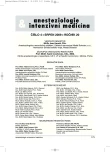iNO in acute respiratory failure of the newborns. A comparison of its combination with CMV and HFOV
Authors:
Lukáš Marek 1; Vobruba Václav 2; Košut Peter 1; Srnský Pavel 2; Žurek Jiří 1; Koudelková Ludmila 1; Košinová Lucie 1; Fedora Michal 1
Authors‘ workplace:
Klinika dětské anesteziologie a resuscitace Lékařské fakulty Masarykovy univerzity a Fakultní nemocnice Brno
1; Jednotka intenzivní a resuscitační péče Kliniky dětského a dorostového lékařství Všeobecné fakultní nemocnice v Praze
2
Published in:
Anest. intenziv. Med., 20, 2009, č. 4, s. 176-184
Category:
Intensive Care Medicine - Original Paper
Overview
Objective:
To compare the effect of inhaled nitric oxide (iNO) combined with conventional mechanical ventilation (CMV) or high-frequency oscillatory ventilation (HFOV) on oxygenation and ventilation parameters, complications rates and mortality in newborns with acute hypoxic respiratory failure (AHRF).
Design:
A prospective observational study.
Setting:
The Paediatric Anaesthesia and Intensive Care Clinic, University Hospital Brno, and The Paediatric and Adolescent Medicine Clinic, General University Hospital, Prague.
Materials and methods:
We enrolled in the study newborns with persistent pulmonary hypertension (PPHN) or acute respiratory distress syndrome (ARDS) without congenital heart disease in whom CMV or HFOV had failed. The newborns were divided in the CMV or HFOV groups according to the type of ventilation during iNO therapy. We recorded the following characteristics: the demographic data, duration of hospitalization, mechanical ventilation and iNO therapy, ARDS origin, diagnosis, outcome, iNO concentration; oxygenation, ventilation and acid-base parameters, ventilator settings and complications due to iNO.
Results:
We enrolled 25 newborns. We recorded a temporary improvement in oxygenation in both the groups and in particular in the HFOV group. We did not record any improvement in the ventilation and acid-base parameters. We did not observe an effect on the ventilator settings except for a comparable decrease of FiO2 in both the groups. We did not record any adverse effects. Total mortality was 4%.
Conclusion:
Both the therapeutic combinations improve oxygenation in the newborns with AHRF. HFOV has an additive effect on oxygenation. Either combination did not influence the ventilation or acid-base parameters. Both the methods provided for a similar reduction of FiO2 with no effect on the other ventilator settings. We observed the same low probability of adverse effects of administering iNO up to 20 ppm in both combinations. Either combination did not influence the mortality in neonates with AHRF.
Keywords:
nitric oxide, newborns – Acute Respiratory Failure – oxygenation – Conventional Mechanical Ventilation – High Frequency Oscilatory Ventilation
Sources
1. Roberts, J. D., Polaner, D. M., Lang, P., Zapol, W. M. Inhaled nitric oxide in persistent pulmonary hypertension of the newborn. Lancet, 1992, 3, 340, 8823, p. 818–819.
2. Rossaint, R., Falke, K. J., López, F., Slama, K., Pison, U., Zapol, W. M. Inhaled nitric oxide for the adult respiratory distress syndrome. N. Engl. J. Med., 1993, 11, 328, 6, p. 399–405.
3. Sokol, J., Jacobs, S. E., Bohn, D. Inhaled nitric oxide for acute hypoxic respiratory failure in children and adults: a meta-analysis. Anesth. Analg., 2003, 97, 4, p. 989–998. Review.
4. Macese, D., Field, D., Mercier, J. C., Miller, J. et al. Inhaled nitric oxide therapy in neonates and children: reaching a European consensus. Intensive Care Med., 2004, 30, p. 372–380.
5. Loskote, A. U., Kastle, R. A., Hoo, A. F., Lum, S., Ranganathan, S. C., Mok, Q. Q., Stocks, J. Airway function in infants treated with inhaled nitric oxide for persistent pulmonary hypertension. Pediatr. Pulmonol., 2008, 43, 3, p. 224–235.
6. Skýtsky, A. S. et al. ACCP Consensus Conference: mechanical ventilation. Intensive Care Med., 1994, 20, p. 64–79.
7. Fedora, M. Vliv terapeutického protokolu na mortalitu syndromu akutní respirační tísně v dětském věku. Habilitační práce, 2005, LF MU Brno, p. 44–47.
8. Cockburn, F., Cooke, R. W. I., Gamsu, H. R., Greenough, A., Hopkána, A., Macintosh, N., Ogstont, S. A., Parry, G. J., Silverman, M., Shaw, J. C. L., Tarnow-Mordi, W. O., Wilkinson, A. R. CRIB investigators’ Group and writing committee: The CRIB (clinical risk index for babies) score: a tool for assessing initial neonatal risk and comparing performance of neonatal intensive care units. Lancet, 1993, 342, p. 193–198.
9. Wessel, D. L., Adatia, I., Van Marter, L. J., Thompson, J. E., Kane, J. W., Stark, A. R., Kourembanas, S. Improved Oxygenation in a Randomized Trial of Inhaled Nitric Oxide for Persistent Pulmonary Hypertension of the Newborn. Pediatrics, 1997, 100, 5, p. E7.
10. Davidson, D., Barefield, E. S., Kattwinkel, J., Dudel, G., Damask, M., Straube, R., Rhines, J., Chány, C. T. Inhaled nitric oxide for the early treatment of persistent pulmonary hypertension of the term newborn: a randomized, double-masked, placebo-controlled, dose-response, multicenter study. Pediatrics, 1998, 101, 3 Pt 1, p. 325–334.
11. Kinsella, J. P., Axman, S. H. Inhaled Nitric Oxide Therapy in Children. Pediatric Respiratory Reviews, 2005, 6, 3, p. 190–198. Review.
Labels
Anaesthesiology, Resuscitation and Inten Intensive Care MedicineArticle was published in
Anaesthesiology and Intensive Care Medicine

2009 Issue 4
Most read in this issue
- The utilization of fiberoptic bronchoscopy in intensive care
- A patient with severe and protracted hypoglycaemia
- Early identification of critically ill patients with the MEDICAL EMERGENCY SYSTEM in St. Ann University Hospital, Brno
- Measurement of trans-alveolar pressure with a pulmonary artery catheter
